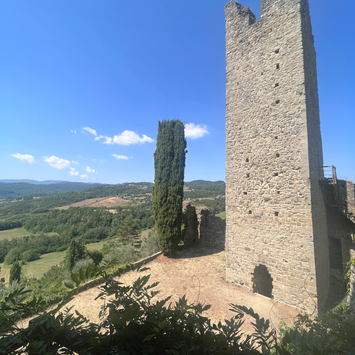
Castello di Romena
The castle is located near Pratovecchio, nestled amidst the beautiful countryside and offers panoramic views of the surrounding landscape. It was originally built as a defensive fortress, but over the centuries, it has undergone various renovations and transformations. Today, it stands as a picturesque reminder of Italy's medieval past.

Opening hours
April
Friday to Sunday and Public Holidays
10:00 a.m. - 1:30 p.m. / 2:30 p.m. - 6:00 p.m.
1 to 5 May
10:00 a.m. - 1:30 p.m. / 2:30 p.m. - 7:00 p.m.
May - June
Friday to Sunday and Public Holidays
10:00 a.m. - 1:30 p.m. / 2:30 p.m. - 7:00 p.m.
July - August
Everyday
10:00 a.m. - 2:00 p.m. / 3:00 p.m. - 8:00 p.m.
1 to 15 September
Everyday
10:00 a.m. - 1:30 p.m. / 2:30 p.m. - 7:00 p.m.
16 to 30 September
Friday to Sunday
10:00 a.m. - 1:30 p.m. / 2:30 p.m. - 7:00 p.m.
October - 3 November
Friday to Sunday and Public Holidays
10:00 a.m. - 1:30 p.m. / 2:30 p.m. - 6:00 p.m.
The origins of Castello di Romena trace back to the medieval era, likely around the 11th or 12th century. Like many castles in Tuscany, it was constructed as a defensive fortress to protect the surrounding territory.
Over the centuries, Castello di Romena changed hands several times as various noble families vied for control of the region. Records indicate that the castle was owned by the powerful Guidi family, who were prominent feudal lords in Tuscany during the Middle Ages. The castle occupied a strategic position along trade routes and served as a stronghold for its owners.
Cultural and Literary Connections: Castello di Romena is often associated with Dante Alighieri, the renowned Italian poet and author of the Divine Comedy. According to local legend, Dante sought refuge in the castle during his exile from Florence. While the historical accuracy of this claim is uncertain, it adds to the castle's cultural significance.
Like many medieval fortresses, Castello di Romena experienced periods of decline and neglect over the centuries. However, in recent years, efforts have been made to restore and preserve the castle's architectural heritage. Restoration projects have aimed to maintain its historical integrity while also making it accessible to visitors.
Today, Castello di Romena stands as a testament to Italy's medieval past, offering visitors a glimpse into the region's rich history and cultural heritage. Its picturesque setting, combined with its historical significance, makes it a popular destination for tourists exploring the Tuscan countryside.







